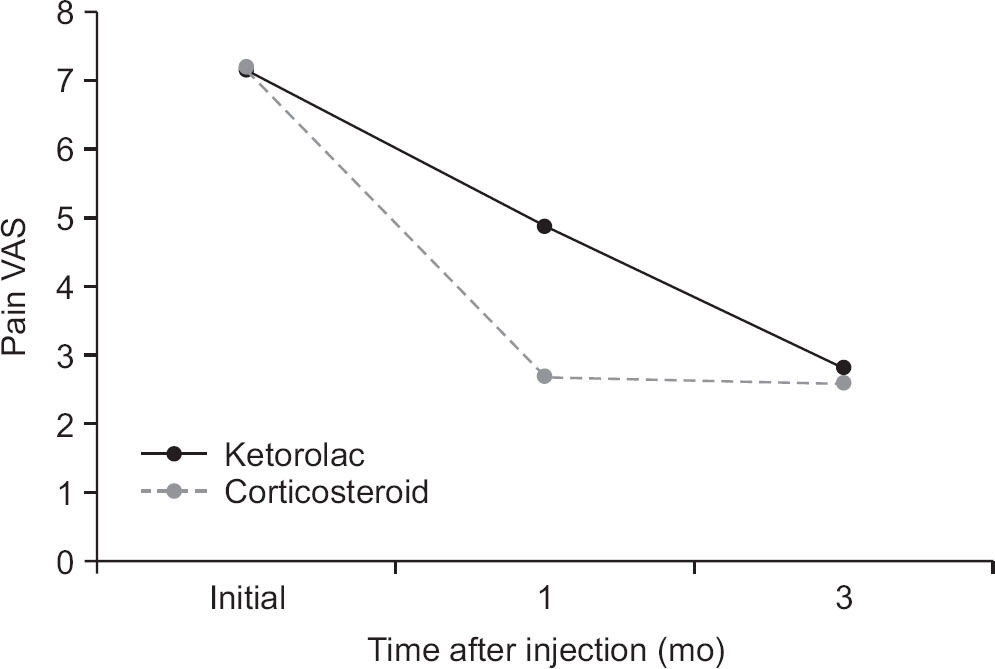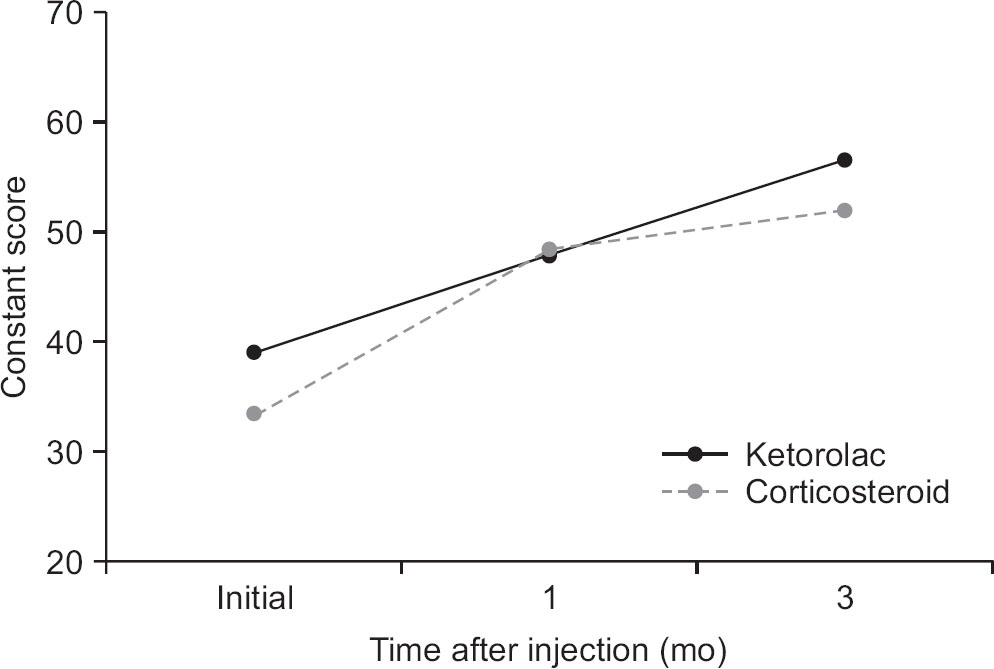J Korean Orthop Assoc.
2017 Apr;52(2):170-177. 10.4055/jkoa.2017.52.2.170.
Early Clinical Outcomes after Subacromial Injection of Ketorolac in Patients with Shoulder Impingement Syndrome: A Comparison with Steroid Injection
- Affiliations
-
- 1Department of Orthopaedic Surgery, National Police Hospital, Seoul, Korea. nphos@hanmail.net
- KMID: 2438982
- DOI: http://doi.org/10.4055/jkoa.2017.52.2.170
Abstract
- PURPOSE
The purpose of this study was to compare the clinical results between the subacromial injection of the ketorolac and that of the corticosteroid in patients with subacromial shoulder impingement syndrome.
MATERIALS AND METHODS
Twenty patients with shoulder impingement syndrome received an injection of 60 mg ketorolac and were evaluated in terms of visual analogue scale (VAS), range of motion (ROM) and Constant-Murley score. The outcomes are compared with the data of patients treated by 40 mg triamcinolone injection, retrospectively.
RESULTS
There was no significant difference in the demographics, VAS, ROM, and Constan-Murley score between the two groups before the injection. At the 4 weeks follow-up, pain improvement was significantly greater in the corticosteroid group (2.7±1.53) than in the ketorolac group (4.9±2.08; p=0.001). However 12 weeks after the injection, there was no significant difference in pain improvement between the two groups (ketorolac: 2.9±2.32, corticosteroid: 2.6±1.82; p=0.707). The Constant-Murley score at the final follow-up improved from 33.5 to 52.1 in the corticosteroid group, and from 39.0 to 56.6 in the ketorolac group (p=0.677). ROM was increased in both groups, and external rotation was significantly greater in the ketorolac group than in the corticosteroid group at the final follow-up (ketorolac: 29.3°±9.90°, corticosteroid: 20.8°±7.99°; p=0.005).
CONCLUSION
In this study, ketolorac provided an effect equivalent to triamcinolone in the treatment of subacromial shoulder impingement syndrome at 12 weeks after the injection. This result could offer better opportunities to manage patients with diabetes or local and systemic side effects of repetitive use of corticosteroids.
Keyword
MeSH Terms
-
Adrenal Cortex Hormones
Anti-Inflammatory Agents, Non-Steroidal
Demography
Follow-Up Studies
Glucocorticoids
Humans
Ketorolac*
Range of Motion, Articular
Retrospective Studies
Shoulder Impingement Syndrome*
Shoulder*
Triamcinolone
Adrenal Cortex Hormones
Anti-Inflammatory Agents, Non-Steroidal
Glucocorticoids
Ketorolac
Triamcinolone
Figure
Reference
-
1. Neer CS 2 nd. Anterior acromioplasty for the chronic impingement syndrome in the shoulder: a preliminary report. J Bone Joint Surg Am. 1972; 54:41–50.2. Morrison DS, Frogameni AD, Woodworth P. Non-operative treatment of subacromial impingement syndrome. J Bone Joint Surg Am. 1997; 79:732–7.
Article3. Cummins CA, Sasso LM, Nicholson D. Impingement syndrome: temporal outcomes of nonoperative treatment. J Shoulder Elbow Surg. 2009; 18:172–7.
Article4. Blair B, Rokito AS, Cuomo F, Jarolem K, Zuckerman JD. Efficacy of injections of corticosteroids for subacromial impingement syndrome. J Bone Joint Surg Am. 1996; 78:1685–9.
Article5. Berry H, Fernandes L, Bloom B, Clark RJ, Hamilton EB. Clinical study comparing acupuncture, physiotherapy, injection and oral anti-inflammatory therapy in shoulder-cuff lesions. Curr Med Res Opin. 1980; 7:121–6.
Article6. Hawkins RJ, Plancher KD, Saddemi SR, Brezenoff LS, Moor JT. Arthroscopic subacromial decompression. J Shoulder Elbow Surg. 2001; 10:225–30.
Article7. Alvarez CM, Litchfield R, Jackowski D, Griffin S, Kirkley A. A prospective double-blind, randomized clinical trial comparing subacromial injection of betamethasone and xylocaine to xylocaine alone in chronic rotator cuff tendinosis. Am J Sports Med. 2005; 33:255–62.
Article8. Koester MC, Dunn WR, Kuhn JE, Spindler KP. The efficacy of subacromial corticosteroid injection in the treatment of rotator cuff disease: a systematic review. J Am Acad Orthop Surg. 2007; 15:3–11.
Article9. Goldie I. Local steroid therapy in painful orthopaedic conditions. Scott Med J. 1972; 17:176–86.
Article10. Halpern AA, Horowitz BG, Nagel DA. Tendon ruptures associated with corticosteroid therapy. West J Med. 1977; 127:378–82.11. Unverferth LJ, Olix ML. The effect of local steroid injections on tendon. J Sports Med. 1973; 1:31–7.
Article12. Schroeder J, Beredjiklian PK, Matzon JL, Lutsky K, Hoffler CE, Kim N. Elevated hemoglobin A1C levels correlate with blood glucose elevation in diabetic patients following local corticosteroid injection in the hand: a prospective study. J Hand Surg. 2014; 39:e7–8.
Article13. Min KS, St Pierre P, Ryan PM, Marchant BG, Wilson CJ, Arrington ED. A double-blind randomized controlled trial comparing the effects of subacromial injection with corticosteroid versus NSAID in patients with shoulder impingement syndrome. J Shoulder Elbow Surg. 2013; 22:595–601.
Article14. Plafki C, Steffen R, Willburger RE, Wittenberg RH. Local anaesthetic injection with and without corticosteroids for subacromial impingement syndrome. Int Orthop. 2000; 24:40–2.
Article15. McInerney JJ, Dias J, Durham S. Evans A. R and omised controlled trial of single, subacromial injection of methylprednisolone in patients with persistent, post-traumatic imping-ment of the shoulder. Emerg Med J. 2003. 20:p. 218–21.16. Itzkowitch D, Ginsberg F, Leon M, Bernard V, Appelboom T. Peri-articular injection of tenoxicam for painful shoulders: a double-blind, placebo controlled trial. Clin Rheumatol. 1996; 15:604–9.
Article17. Karthikeyan S, Kwong HT, Upadhyay PK, Parsons N, Drew SJ, Griffin D. A double-blind randomised controlled study comparing subacromial injection of tenoxicam or methylprednisolone in patients with subacromial impingement. J Bone Joint Surg Br. 2010. 92:p. 77–82.
Article18. Crass JR, Craig EV, Feinberg SB. The hyperextended internal rotation view in rotator cuff ultrasonography. J Clin Ultrasound. 1987; 15:416–20.
Article19. van der Sande R, Rinkel WD, Gebremariam L, Hay EM, Koes BW, Huisstede BM. Subacromial impingement syndrome: effectiveness of pharmaceutical interventions-nonsteroidal anti-inflammatory drugs, corticosteroid, or other injections: a systematic review. Arch Phys Med Rehabil. 2013; 94:961–76.
Article20. DiPalma JR. Ketorolac: an injectable NSAID. Am Fam Physician. 1991; 43:207–10.21. Wiggins ME, Fadale PD, Ehrlich MG, Walsh WR. Effects of local injection of corticosteroids on the healing of ligaments. A follow-up report. J Bone Joint Surg Am. 1995; 77:1682–91.
Article22. Kleinman M, Gross AE. Achilles tendon rupture following steroid injection. Report of three cases. J Bone Joint Surg Am. 1983; 65:1345–7.
Article23. Maman E, Yehuda C, Pritsch T. . Detrimental effect of repeated and single subacromial corticosteroid injections on the intact and injured rotator cuff: a biomechanical and imaging study in rats. Am J Sports Med. 2016; 44:177–82.24. Watson M. Rotator cuff function in the impingement syndrome. J Bone Joint Surg Br. 1989; 71:361–6.
Article25. Stepan JG, London DA, Boyer MI, Calfee RP. Blood glucose levels in diabetic patients following corticosteroid injections into the hand and wrist. J Hand Surg Am. 2014; 39:706–12.
Article26. Catalano LW 3rd, Glickel SZ, Barron OA, Harrison R, Marshall A, Purcelli-Lafer M.Effect of local corticosteroid injection of the hand and wrist on blood glucose in patients with diabetes mellitus. Orthopedics. 2012; 35:e1754–8.
Article27. Gaujoux-Viala C, Dougados M, Gossec L. Efficacy and safety of steroid injections for shoulder and elbow tendonitis: a meta-analysis of randomised controlled trials. Ann Rheum Dis. 2009; 68:1843–9.
Article28. Smidt N, van der Windt DA, Assendelft WJ, Devillé WL, Korthals-de Bos IB, Bouter LM. Corticosteroid injections, physiotherapy, or a wait-and-see policy for lateral epicondylitis: a randomised controlled trial. Lancet. 2002; 359:657–62.
Article29. Johansson KM, Adolfsson LE. Intraobserver and interobserver reliability for the strength test in the Constant-Murley shoulder assessment. J Shoulder Elbow Surg. 2005; 14:273–8.
Article30. Byun SD, Hong YH, Hong SK. . Effects of repeated steroid injection at subacromial bursa with different interval. Ann Rehabil Med. 2014; 38:805–11.
Article
- Full Text Links
- Actions
-
Cited
- CITED
-
- Close
- Share
- Similar articles
-
- The effects of a single-dose subacromial injection of a nonsteroidal anti-inflammatory drug in geriatric patients with subacromial impingement syndrome: a randomized double-blind study
- Glenohumeral versus subacromial steroid injections for impingement syndrome with mild stiffness: a randomized controlled trial
- Evaluation of Shoulder Impingement Syndrome Using Ultrasonography
- Effects of Subacromial Bursa Injection With Corticosteroid and Hyaluronidase According to Dosage
- The impact of central sensitization-related symptoms on subacromial steroid injection outcomes in patients with subacromial impingement syndrome: an observational study




